操作系统 实验报告一
- 格式:docx
- 大小:688.19 KB
- 文档页数:5
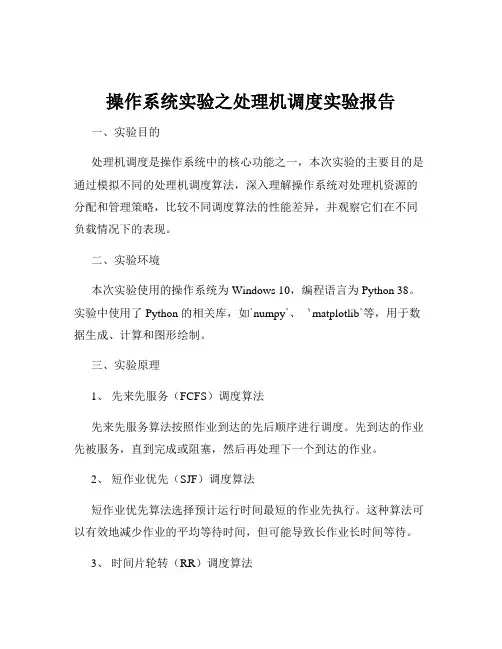
操作系统实验之处理机调度实验报告一、实验目的处理机调度是操作系统中的核心功能之一,本次实验的主要目的是通过模拟不同的处理机调度算法,深入理解操作系统对处理机资源的分配和管理策略,比较不同调度算法的性能差异,并观察它们在不同负载情况下的表现。
二、实验环境本次实验使用的操作系统为 Windows 10,编程语言为 Python 38。
实验中使用了 Python 的相关库,如`numpy`、`matplotlib`等,用于数据生成、计算和图形绘制。
三、实验原理1、先来先服务(FCFS)调度算法先来先服务算法按照作业到达的先后顺序进行调度。
先到达的作业先被服务,直到完成或阻塞,然后再处理下一个到达的作业。
2、短作业优先(SJF)调度算法短作业优先算法选择预计运行时间最短的作业先执行。
这种算法可以有效地减少作业的平均等待时间,但可能导致长作业长时间等待。
3、时间片轮转(RR)调度算法时间片轮转算法将处理机的时间分成固定长度的时间片,每个作业轮流获得一个时间片的处理时间。
当时间片用完后,如果作业还未完成,则将其放入就绪队列的末尾等待下一轮调度。
4、优先级调度算法优先级调度算法为每个作业分配一个优先级,优先级高的作业先被执行。
优先级可以根据作业的性质、紧急程度等因素来确定。
四、实验内容与步骤1、数据生成首先,生成一组模拟的作业,包括作业的到达时间、预计运行时间和优先级等信息。
为了使实验结果更具代表性,生成了不同规模和特征的作业集合。
2、算法实现分别实现了先来先服务、短作业优先、时间片轮转和优先级调度这四种算法。
在实现过程中,严格按照算法的定义和规则进行处理机的分配和调度。
3、性能评估指标定义了以下性能评估指标来比较不同调度算法的效果:平均等待时间:作业在就绪队列中的等待时间的平均值。
平均周转时间:作业从到达系统到完成的时间间隔的平均值。
系统吞吐量:单位时间内完成的作业数量。
4、实验结果分析对每种调度算法进行多次实验,使用不同的作业集合,并记录相应的性能指标数据。
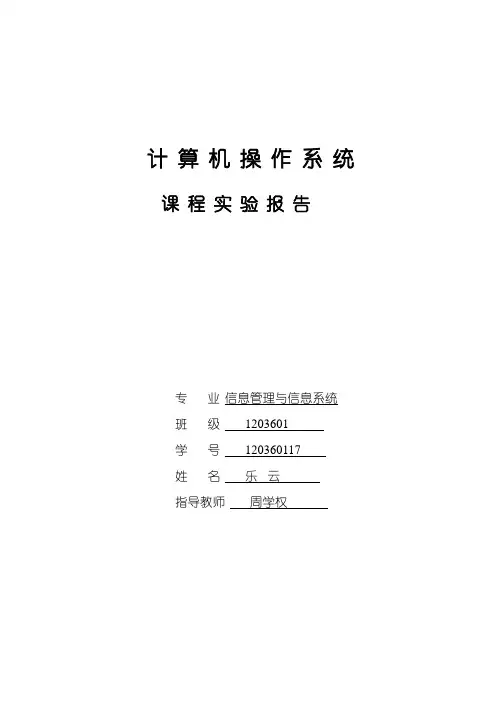
计算机操作系统课程实验报告专业信息管理与信息系统班级 1203601学号 120360117姓名乐云指导教师周学权计算机操作系统课程实验报告专业信息管理与信息系统班级 1203601学号 120360114姓名郭鑫指导教师周学权操作系统实验实验1 使用虚拟机安装系统 4学时【实验目的】1.了解虚拟机软件的使用。
2.了解使用虚拟机安装Windows及Ubuntu操作系统。
【实验内容】1. 安装虚拟机软件VirtualBox。
2. 配置VirtualBox环境安装WindowsXP,并在虚拟机中启动windowsXP。
3. 配置VirtualBox环境安装Ubuntu 10.10,并在虚拟机中启动Ubuntu。
【实验环境】VirtualBox4.0Windows XPUbuntu 8.04【实验过程】一、创建虚拟机首先运行VirtualBox,单击左上角的“新建”。
单击下一步。
出现如下图的界面,在名称后输入自己起的名字,如test选择自己想要安装的系统类型和版本,本次试验是安装windows xp系统设置完成后,单击下一步。
接下来是设置虚拟机的内存大小,本次实验操作的计算机内存为4GB,所以我选择分配给我的虚拟机的内存为512MB,然后单击下一步。
接着创建虚拟硬盘,选择创建新的虚拟硬盘,单击下一步。
选择虚拟硬盘的类型,默认选择了VDI类型,单击下一步。
接下来选择为动态扩展类型,因为计算机的存储空间不大。
单击下一步。
动态扩展:如果你为你的虚拟磁盘分配的是10G空间,虚拟磁盘占用真实磁盘空间的范围就为0~10G。
固定大小:如果你为你的虚拟磁盘分配的是10G空间,虚拟磁盘占用真实磁盘空间永远不是10G,不管虚拟磁盘空间是否被全部使用。
选择虚拟机在本地磁盘中的位置和大小,单击下一步。
确认虚拟机的详细情况,点击下一步。
这时我们已经成功的创建了一个虚拟机了,接下来我们要开始配置这个虚拟机安装操作系统选择刚才创建的虚拟机,然后单击上方的“开始”弹出了首次运行向导,单击下一步。
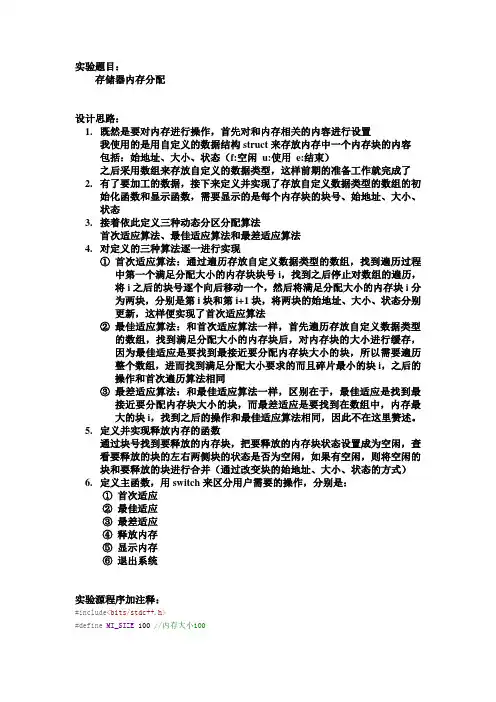
实验题目:存储器内存分配设计思路:1.既然是要对内存进行操作,首先对和内存相关的内容进行设置我使用的是用自定义的数据结构struct来存放内存中一个内存块的内容包括:始地址、大小、状态(f:空闲u:使用e:结束)之后采用数组来存放自定义的数据类型,这样前期的准备工作就完成了2.有了要加工的数据,接下来定义并实现了存放自定义数据类型的数组的初始化函数和显示函数,需要显示的是每个内存块的块号、始地址、大小、状态3.接着依此定义三种动态分区分配算法首次适应算法、最佳适应算法和最差适应算法4.对定义的三种算法逐一进行实现①首次适应算法:通过遍历存放自定义数据类型的数组,找到遍历过程中第一个满足分配大小的内存块块号i,找到之后停止对数组的遍历,将i之后的块号逐个向后移动一个,然后将满足分配大小的内存块i分为两块,分别是第i块和第i+1块,将两块的始地址、大小、状态分别更新,这样便实现了首次适应算法②最佳适应算法:和首次适应算法一样,首先遍历存放自定义数据类型的数组,找到满足分配大小的内存块后,对内存块的大小进行缓存,因为最佳适应是要找到最接近要分配内存块大小的块,所以需要遍历整个数组,进而找到满足分配大小要求的而且碎片最小的块i,之后的操作和首次遍历算法相同③最差适应算法:和最佳适应算法一样,区别在于,最佳适应是找到最接近要分配内存块大小的块,而最差适应是要找到在数组中,内存最大的块i,找到之后的操作和最佳适应算法相同,因此不在这里赘述。
5.定义并实现释放内存的函数通过块号找到要释放的内存块,把要释放的内存块状态设置成为空闲,查看要释放的块的左右两侧块的状态是否为空闲,如果有空闲,则将空闲的块和要释放的块进行合并(通过改变块的始地址、大小、状态的方式)6.定义主函数,用switch来区分用户需要的操作,分别是:①首次适应②最佳适应③最差适应④释放内存⑤显示内存⑥退出系统实验源程序加注释:#include<bits/stdc++.h>#define MI_SIZE 100 //内存大小100typedef struct MemoryInfomation//一个内存块{int start; //始地址int Size; //大小char status; //状态 f:空闲 u:使用 e:结束} MI;MI MList[MI_SIZE];void InitMList() //初始化{int i;MI temp = { 0,0,'e' };for (i = 0; i < MI_SIZE; i++){MList[i] = temp;}MList[0].start = 0; //起始为0MList[0].Size = MI_SIZE;//大小起始最大MList[0].status = 'f'; //状态起始空闲}void Display() //显示{int i, used = 0;printf("\n---------------------------------------------------\n");printf("%5s%15s%15s%15s", "块号", "始地址", "大小", "状态");printf("\n---------------------------------------------------\n");for (i = 0; i < MI_SIZE && MList[i].status != 'e'; i++){if (MList[i].status == 'u'){used += MList[i].Size;}printf("%5d%15d%15d%15s\n", i, MList[i].start, MList[i].Size, MList[i].status == 'u' ? "使用" : "空闲");}printf("\n----------------------------------------------\n");}void FirstFit(){int i, j, flag = 0;int request;printf("最先适应算法:请问你要分配多大的内存\n");scanf("%d", &request);for (i = 0; i < MI_SIZE && MList[i].status != 'e'; i++){if (MList[i].Size >= request && MList[i].status == 'f') {if (MList[i].Size - request <= 0){MList[i].status = 'u';}else{for (j = MI_SIZE - 2; j > i; j--){MList[j + 1] = MList[j];}MList[i + 1].start = MList[i].start + request; MList[i + 1].Size = MList[i].Size - request;MList[i + 1].status = 'f';MList[i].Size = request;MList[i].status = 'u';flag = 1;}break;}}if (flag != 1 || i == MI_SIZE || MList[i].status == 'e'){printf("没有足够大小的空间分配\n");}Display();}void BadFit(){int i, j = 0, k = 0, flag = 0, request;printf("最坏适应算法:请问你要分配多大的内存\n");scanf("%d", &request);for (i = 0;i < MI_SIZE - 1 && MList[i].status != 'e';i++){if (MList[i].Size >= request && MList[i].status == 'f') {flag = 1;if (MList[i].Size > k){k = MList[i].Size;j = i;}}}i = j;if (flag == 0){printf("没有足够大小的空间分配\n");j = i;}else if (MList[i].Size - request <= 0){MList[i].status = 'u';}else{for (j = MI_SIZE - 2;j > i;j--){MList[j + 1] = MList[j];}MList[i + 1].start = MList[i].start + request;MList[i + 1].Size = MList[i].Size - request;MList[i + 1].status = 'f';MList[i].Size = request;MList[i].status = 'u';}Display();}void M_Release() //释放内存{int i, number;printf("\n请问你要释放哪一块内存:\n");scanf("%d", &number);if (MList[number].status == 'u'){MList[number].status = 'f';if (MList[number + 1].status == 'f')//右边空则合并{MList[number].Size += MList[number].Size;for (i = number + 1; i < MI_SIZE - 1 && MList[i].status != 'e'; i++) { //i后面的每一个结点整体后移if (i > 0){MList[i] = MList[i + 1];}}}if (number > 0 && MList[number - 1].status == 'f')//左边空则合并{MList[number - 1].Size += MList[number].Size;for (i = number; i < MI_SIZE - 1 && MList[i].status != 'e'; i++){MList[i] = MList[i + 1];}}}else{printf("该块内存无法正常释放\n");}Display();}void BestFit(){int i, j = 0, t, flag = 0, request;printf("最佳适应算法:请问你要分配多大的内存\n");scanf("%d", &request);t = MI_SIZE;for (i = 0; i < MI_SIZE && MList[i].status != 'e'; i++){if (MList[i].Size >= request && MList[i].status == 'f'){flag = 1;if (MList[i].Size < t){t = MList[i].Size;j = i;}}}i = j;if (flag == 0){printf("没有足够大小的空间分配\n");j = i;}else if (MList[i].Size - request <= 0){MList[i].status = 'u';}else {for (j = MI_SIZE - 2; j > i; j--){MList[j + 1] = MList[j];}MList[i + 1].start = MList[i].start + request;MList[i + 1].Size = MList[i].Size - request;MList[i + 1].status = 'f';MList[i].Size = request;MList[i].status = 'u';}Display();}int main(){int x;InitMList();while (1){printf(" \n"); printf(" 1.首次适应\n");printf(" 2.最佳适应\n");printf(" 3.最差适应\n"); printf(" 4.释放内存\n"); printf(" 5.显示内存\n"); printf(" 6.退出系统\n"); printf("请输入1-6:");scanf("%d", &x);switch (x){case 1:FirstFit();break;case 2:BestFit();break;case 3:BadFit();break;case 4:M_Release();break;case 5:Display();break;case 6:exit(0);}}return 0;}实验测试结果记录:1.首次适应2.最佳适应3.最差适应4.释放内存5.显示内存6.退出系统请输入1-6:1最先适应算法:请问你要分配多大的内存10---------------------------------------------------块号始地址大小状态---------------------------------------------------0 0 10 使用1 10 90 空闲----------------------------------------------1.首次适应2.最佳适应3.最差适应4.释放内存5.显示内存6.退出系统请输入1-6:1最先适应算法:请问你要分配多大的内存25---------------------------------------------------块号始地址大小状态---------------------------------------------------0 0 10 使用1 10 25 使用2 35 65 空闲----------------------------------------------1.首次适应2.最佳适应3.最差适应4.释放内存5.显示内存6.退出系统请输入1-6:1最先适应算法:请问你要分配多大的内存15---------------------------------------------------块号始地址大小状态---------------------------------------------------0 0 10 使用1 10 25 使用2 35 15 使用3 50 50 空闲----------------------------------------------1.首次适应2.最佳适应3.最差适应4.释放内存5.显示内存6.退出系统请输入1-6:1最先适应算法:请问你要分配多大的内存20---------------------------------------------------块号始地址大小状态---------------------------------------------------0 0 10 使用1 10 25 使用2 35 15 使用3 50 20 使用4 70 30 空闲----------------------------------------------1.首次适应2.最佳适应3.最差适应4.释放内存5.显示内存6.退出系统请输入1-6:4请问你要释放哪一块内存:---------------------------------------------------块号始地址大小状态---------------------------------------------------0 0 10 空闲1 10 25 使用2 35 15 使用3 50 20 使用4 70 30 空闲----------------------------------------------1.首次适应2.最佳适应3.最差适应4.释放内存5.显示内存6.退出系统请输入1-6:4请问你要释放哪一块内存:2---------------------------------------------------块号始地址大小状态---------------------------------------------------0 0 10 空闲1 10 25 使用2 35 15 空闲3 50 20 使用4 70 30 空闲----------------------------------------------1.首次适应2.最佳适应3.最差适应4.释放内存5.显示内存6.退出系统请输入1-6:2最佳适应算法:请问你要分配多大的内存5---------------------------------------------------块号始地址大小状态---------------------------------------------------0 0 5 使用1 5 5 空闲2 10 25 使用3 35 15 空闲4 50 20 使用5 70 30 空闲----------------------------------------------1.首次适应2.最佳适应3.最差适应4.释放内存5.显示内存6.退出系统请输入1-6:3最坏适应算法:请问你要分配多大的内存25---------------------------------------------------块号始地址大小状态---------------------------------------------------0 0 5 使用1 5 5 空闲2 10 25 使用3 35 15 空闲4 50 20 使用5 70 25 使用6 95 5 空闲----------------------------------------------1.首次适应2.最佳适应3.最差适应4.释放内存5.显示内存6.退出系统请输入1-6:总结与自评:总结:分区存储管理是操作系统进行内存管理的一种方式。
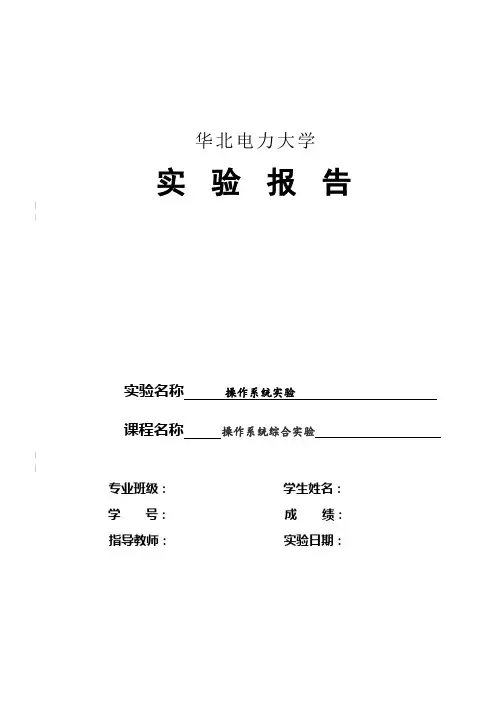
华北电力大学实验报告||实验名称操作系统实验课程名称操作系统综合实验||专业班级:学生姓名:学号:成绩:指导教师:实验日期:华北电力大学实验报告工具包集合。
EOS SDK文件夹主要包括INC头文件、LIB文件夹导入库文件和BIN文件夹动态链接库,可执行程序,二进制文件。
EOS SDK包含的头文件有:eos.h负责导出API函数声明;eosdef.h负责导出函数类型的定义;error.h 负责导出错误码。
四.实验过程1.新建Windows控制台应用程序生成项目:执行项目:调试项目:2.使用断点终端执行:查看EOS SDK(Software Development Kit)文件夹:修改EOS应用程序项目名称:五.实验心得这次是验证性试验,具体步骤和操作方法都是与实验教程参考书上一致,实验很顺利,实验过程没有遇到困难。
通过这次实验,我掌握了OS Lab启动和退出操作;练习使用OS Lab编写一个Windows控制台应用程序,熟悉OS Lab 的基本使用方法新建项目、生成项目、调试项目等。
第页共页华北电力大学实验报告第页共页华北电力大学实验报告第页共页2. 当loop线程在控制台1中执行,并且在控制台2中执行suspend命令时,为什么控制台1中的loop线程处于就绪状态而不是运行状态?3. 在本实验3.2节中只调试了图5-3中显示的最主要的四种转换过程,对于线程由新建进入就绪状态,或者由任意状态进入结束状态的转换过程还没有调试,请读者找到这两个转换过程执行的源代码,自己练习调试。
4. 总结一下在图5-3中显示的转换过程,哪些需要使用线程控制块中的上下文(将线程控制块中的上下文恢复到处理器中,或者将处理器的状态复制到线程控制块的上下文中),哪些不需要使用,并说明原因。
5. 在本实验3.2节中总结的所有转换过程都是分步骤进行的,为了确保完整性,显然这些转换过程是不应该被打断的,也就是说这些转换过程都是原语操作(参见本书第2.6节)。
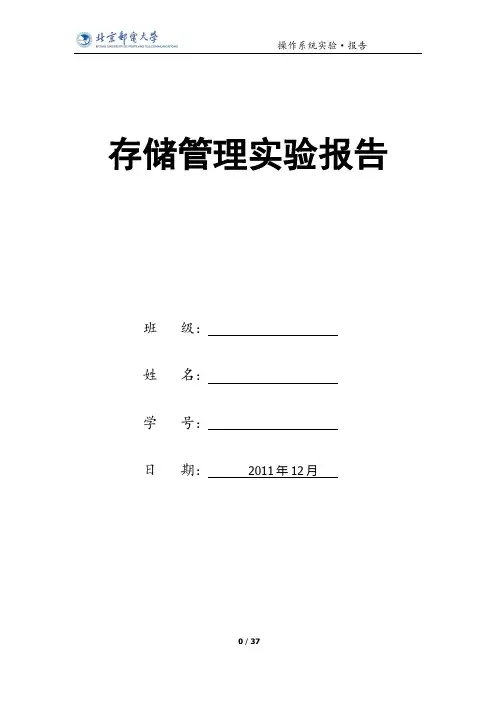
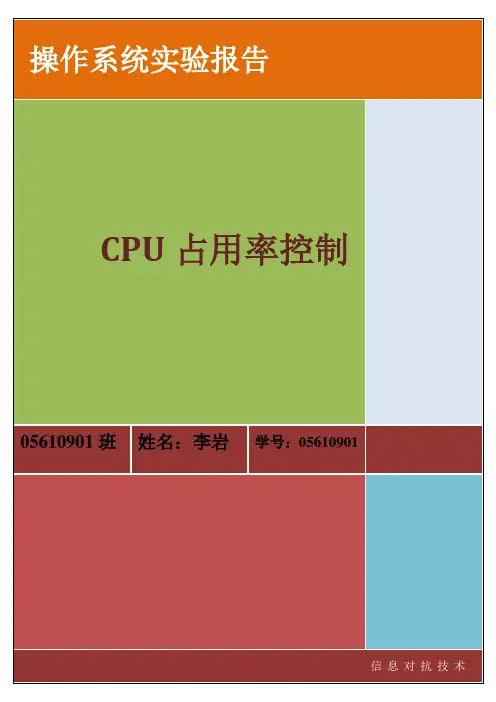
实验一:CPU占用率控制一、实验目的1、通过编写和调试程序以加深对CPU调度的理解;2、熟悉Windows任务管理器CPU信息的获取和使用方法;二、实验要求编写程序实现下面任意一题:1、CPU占用率为一条直线,固定在50%;2、CPU占用率为一条正弦曲线。
三、实验原理在任务管理器的一个刷新周期内,CPU忙(执行应用程序)的时间和刷新周期总时间的比率,就是CPU的占用率,也就是说,任务管理器中显示的是每个刷新周期内CPU占用率的统计平均值。
通过控制程序在任务管理器的刷新期间内忙/闲的比例,就可以控制管理器的CPU占有率。
问题的关键在于如何控制两个loop的时间。
四、实验内容及结果1、实现CPU占用率为一条直线,固定在50%;分析:GetTickCount()可以得到“系统启动到现在”的毫秒值,最多能够统计到49.7天。
另外,利用Sleep()函数,最多也只能精确到1毫秒。
因此,可以在“毫秒”这个量级做操作和比较。
步骤1要操纵CPU的usage曲线,就需要使CPU在一段时间内跑busy和idle两个不同的循环,从而通过不同的时间比例来获得调节CPU占用率的控制。
步骤2利用GetTickCount()来实现busy loop的循环,用Sleep()实现idle loop。
实验源程序:#include <windows.h>int main(void){//50%int busyTime=10;int idleTime=busyTime;_int64 startTime;SetThreadAffinityMask(GetCurrentProcess(), 0x00000001);while(true){startTime=GetTickCount(); //获取从系统从开机到此刻//为止运行的时间while((GetTickCount()-startTime)<=busyTime){;}Sleep(idleTime);}return 0;}实验结果:(图一CPU占用率为一条直线,固定在50%)2、CPU占用率为一条正弦曲线。
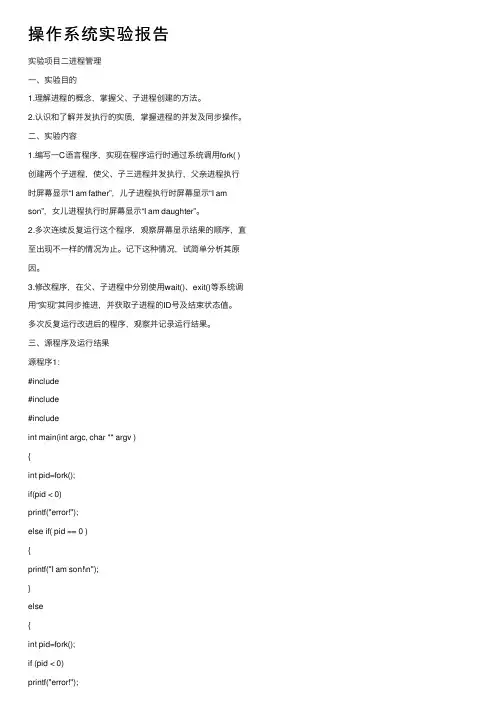
操作系统实验报告实验项⽬⼆进程管理⼀、实验⽬的1.理解进程的概念,掌握⽗、⼦进程创建的⽅法。
2.认识和了解并发执⾏的实质,掌握进程的并发及同步操作。
⼆、实验内容1.编写⼀C语⾔程序,实现在程序运⾏时通过系统调⽤fork( )创建两个⼦进程,使⽗、⼦三进程并发执⾏,⽗亲进程执⾏时屏幕显⽰“I am father”,⼉⼦进程执⾏时屏幕显⽰“I am son”,⼥⼉进程执⾏时屏幕显⽰“I am daughter”。
2.多次连续反复运⾏这个程序,观察屏幕显⽰结果的顺序,直⾄出现不⼀样的情况为⽌。
记下这种情况,试简单分析其原因。
3.修改程序,在⽗、⼦进程中分别使⽤wait()、exit()等系统调⽤“实现”其同步推进,并获取⼦进程的ID号及结束状态值。
多次反复运⾏改进后的程序,观察并记录运⾏结果。
三、源程序及运⾏结果源程序1:#include#include#includeint main(int argc, char ** argv ){int pid=fork();if(pid < 0)printf("error!");else if( pid == 0 ){printf("I am son!\n");}else{int pid=fork();if (pid < 0)printf("error!");else if( pid == 0 ){printf(“I am daughter! \n");}elseprintf("I am father!\n");}sleep(1);return 0;}运⾏结果:源程序2:#include#include#includeint main(int argc, char ** argv ) {char *message;int n;int pid=fork();if(pid < 0)printf("error!");else if( pid == 0 ){message="I am daughter!"; pid=getpid();n=3;}else{int pid=fork();if (pid < 0)printf("error!");else if( pid == 0 ){message="I am son!";pid=getpid();n=3;}elsemessage="I am father!";n=3;}for(;n>0;n--){puts(message);sleep(1);}return 0;}运⾏结果:四、实验分析与总结1.实验内容1运⾏结果为什么⽆固定顺序,fork()函数创建进程是如何并发执⾏的。
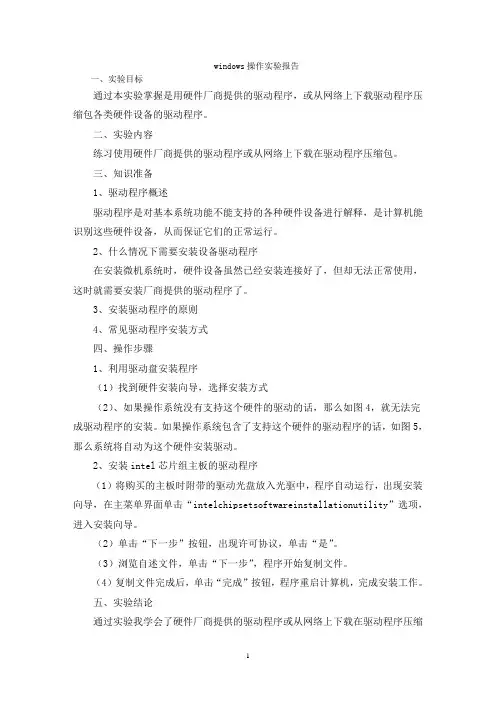
windows操作实验报告一、实验目标通过本实验掌握是用硬件厂商提供的驱动程序,或从网络上下载驱动程序压缩包各类硬件设备的驱动程序。
二、实验内容练习使用硬件厂商提供的驱动程序或从网络上下载在驱动程序压缩包。
三、知识准备1、驱动程序概述驱动程序是对基本系统功能不能支持的各种硬件设备进行解释,是计算机能识别这些硬件设备,从而保证它们的正常运行。
2、什么情况下需要安装设备驱动程序在安装微机系统时,硬件设备虽然已经安装连接好了,但却无法正常使用,这时就需要安装厂商提供的驱动程序了。
3、安装驱动程序的原则4、常见驱动程序安装方式四、操作步骤1、利用驱动盘安装程序(1)找到硬件安装向导,选择安装方式(2)、如果操作系统没有支持这个硬件的驱动的话,那么如图4,就无法完成驱动程序的安装。
如果操作系统包含了支持这个硬件的驱动程序的话,如图5,那么系统将自动为这个硬件安装驱动。
2、安装intel芯片组主板的驱动程序(1)将购买的主板时附带的驱动光盘放入光驱中,程序自动运行,出现安装向导,在主菜单界面单击“intelchipsetsoftwareinstallationutility”选项,进入安装向导。
(2)单击“下一步”按钮,出现许可协议,单击“是”。
(3)浏览自述文件,单击“下一步”,程序开始复制文件。
(4)复制文件完成后,单击“完成”按钮,程序重启计算机,完成安装工作。
五、实验结论通过实验我学会了硬件厂商提供的驱动程序或从网络上下载在驱动程序压缩包。
一、实验任务:通过学习本次实验了解系统备份的重要性,掌握使用ghost 软件实现系统数据备份和还原的方法。
二、实验内容:练习使用ghost软件实现系统备份和还原以及硬盘的复制。
三、实验要点:通过学习了解系统数据的重要性,熟练掌握利用软件对系统进行备份、还原及备份。
四、知识准备:1、系统的备份和还原2、了解ghost软件的概述3、了解什么情况下应该备份和还原系统。
4、掌握ghost的各种界面。
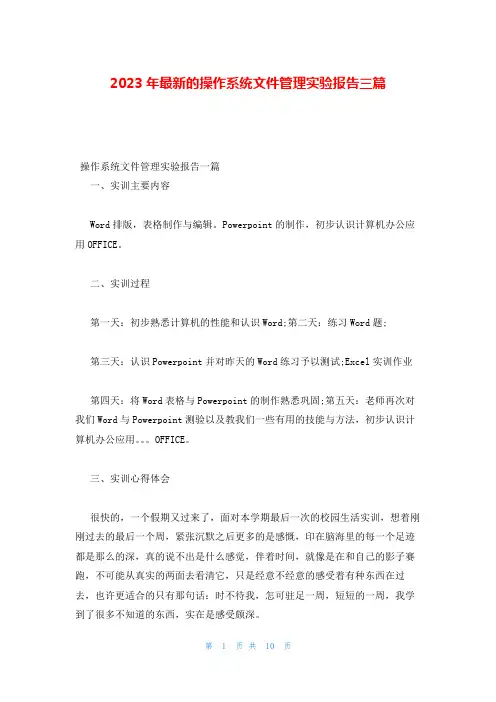
2023年最新的操作系统文件管理实验报告三篇操作系统文件管理实验报告一篇一、实训主要内容Word排版,表格制作与编辑。
Powerpoint的制作,初步认识计算机办公应用OFFICE。
二、实训过程第一天:初步熟悉计算机的性能和认识Word;第二天:练习Word题;第三天:认识Powerpoint并对昨天的Word练习予以测试;Excel实训作业第四天:将Word表格与Powerpoint的制作熟悉巩固;第五天:老师再次对我们Word与Powerpoint测验以及教我们一些有用的技能与方法,初步认识计算机办公应用。
OFFICE。
三、实训心得体会很快的,一个假期又过来了,面对本学期最后一次的校园生活实训,想着刚刚过去的最后一个周,紧张沉默之后更多的是感慨,印在脑海里的每一个足迹都是那么的深,真的说不出是什么感觉,伴着时间,就像是在和自己的影子赛跑,不可能从真实的两面去看清它,只是经意不经意的感受着有种东西在过去,也许更适合的只有那句话:时不待我,怎可驻足一周,短短的一周,我学到了很多不知道的东西,实在是感受颇深。
当今企业竞争范围的伴随社会市场经济的发展以及信息化程度的不断提高而日益扩大,这样就要求企业在各个方面加强管理,要求企业有更高的信息化集成来实现对企业的整体资源进行集成管理。
现代企业都意识到,企业之间的竞争是综合实力的竞争,要求企业有更强的资金实力,具备强有力的管理能力和更快的市场响应速度。
因此,引入计算机系统的意义是非常重大的。
在社会主义市场经济高速发展的今天,如果计算机的各项管理运做仍然停滞在以纸、笔为主要工具的阶段,就会因为信息量的快速增长而无法迅速、准确的运用计算机完成各项工作,这样,必将成为企业各方面发展的一个瓶颈。
而在当代这个以信息时代为主题的社会里,计算机技术高速发展,将信息技术应用于对现代企业的管理日益普及。
计算机技术不但可以提高信息的处理速度和提高信息处理的准确性,更重要的是,可以进一步的解放劳动力,将他们分配到更需要人力资源的岗位上去,从而加快社会工作的现代化、综合化的发展步伐。

山东大学操作系统实验报告HEN system office room 【HEN16H-HENS2AHENS8Q8-HENH1688】操作系统实验报告计算机科学与技术学院目录一、进程控制实验实验目的加深对于进程并发执行概念的理解。
实践并发进程的创建和控制方法。
观察和体验进程的动态特性。
进一步理解进程生命期期间创建、变换、撤销状态变换的过程。
掌握进程控制的方法,了解父子进程间的控制和协作关系。
练习 Linux 系统中进程创建与控制有关的系统调用的编程和调试技术。
示例实验实验内容以下实验示例程序应实现一个类似shell 子命令的功能,它可以从执行程序中启动另一个新的子进程并执行一个新的命令和其并发执行。
实验演示结果独立实验实验内容参考以上示例程序中建立并发进程的方法,编写一个父子协作进程,父进程创建一个子进程并控制它每隔 3 秒显示一次当前目录中的文件名列表。
实验步骤算法设计通过进程间的通讯,先创建一个父进程一个子进程,父进程沉睡3秒,子进程作为当前父进程再次创建一个他的子进程,当前子进程执行显示当前目录文件列表功能,执行execve()方法后死亡。
While(1)在死循环里无限进行当前操作。
即达到父进程创建一个子进程并控制它每隔3秒显示一次当前目录中的文件名列表的要求。
开发调试过程打开一终端命令行窗体,新建一个文件夹,在该文件夹中建立名为的C 语言程序;再建立以下名为的 C 语言头文件;建立项目管理文件 Makefile;输入 make 命令编译连接生成可执行的 pctl 程序;执行 pctl 程序;再次执行带有子进程指定执行命令的 pctl 程序。
思考与分析1.反映的进程的特征和功能,在真实的操作系统中是怎样实现和反映出教材中讲解的进程的生命期、进程的实体和进程状态控制的。
对于进程概念和并发概念有哪些新的理解和认识子进程是如何创建和执行新程序的答:进程是一个可并发执行的程序在某数据集上的一次运行,是程序的一次运行过程。
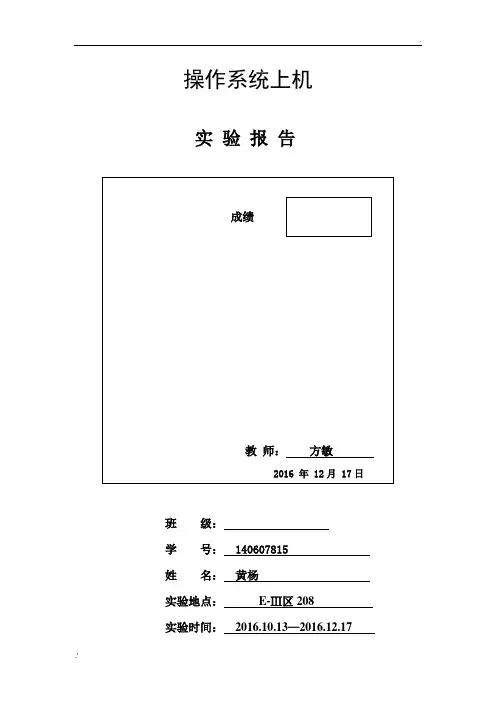
实验一Linux的基本操作和常用命令的使用一、实验目的1.学会安装Linux操作系统2.掌握Linux系统的一些基本操作3.掌握常用Linux命令的使用方法4.了解Linux命令中参数选项的用法和作用二、实验环境1.Linux软件和计算机三、实验内容或步骤1.安装Linux操作系统,并进行相关配置。
2.基本操作和常用命令。
(一).文件操作命令(1)查看文件与目录用以下命令查看文件与目录:ls /usr/binls –ldir(2)显示文件内容命令(cat)设当前目录下包括两个文件text1、text2,用以下列命令了解cat命令的使用:cat text1cat text1 text2>text3cat text3|more(3)文件复制命令(cp)了解cp命令的功能和使用技巧,并注意它们的区别:cp /root/* /tempcp readme text4cp –r /root/* /temp (带目录复制)cp /root/.[a-z]* /temp (复制所有小写字母开头的隐藏文件)(4)文件改名命令(mv)了解mv命令的功能和使用方法,并注意各命令的区别:mv text4 newtextmv newtext /home(5)删除文件命令(rm)了解rm命令的功能和使用方法:rm newtext(二).目录操作命令的使用(1)改变当前目录命令(cd)和显示当前目录命令(pwd)掌握cd命令的功能和使用,并了解以下各命令的区别:cd /rootcd .. (返回上一级目录)cd (返回到用户目录内)pwd (显示当前目录在文件系统层次中的位置)(2)建立子目录命令(mkdir)在用户目录下创建如图5-4所示的目录结构。
(3)删除子目录命令(rmdir)在图5-4所建立的目录结构中,删除a1和b1目录。
命令如下:rmdir /home/X/b1rm –r /home/X/a1rm –rf /home/X/a1注意:可选项-r和-f的作用。
.. 西安交通大学实验报告操作系统实验报告2130505133计算机36班操作系统实验实验一:用户接口实验实验目的1)理解面向操作命令的接口Shell。
2)学会简单的shell编码。
3)理解操作系统调用的运行机制。
4)掌握创建系统调用的方法。
操作系统给用户提供了命令接口和程序接口(系统调用)两种操作方式。
用户接口实验也因此而分为两大部分。
首先要熟悉Linux的基本操作命令,并在此基础上学会简单的shell 编程方法。
然后通过想Linux内核添加一个自己设计的系统调用,来理解系统调用的实现方法和运行机制。
在本次实验中,最具有吸引力的地方是:通过内核编译,将一组源代码变成操作系统的内核,并由此重新引导系统,这对我们初步了解操作系统的生成过程极为有利。
实验内容1)控制台命令接口实验该实验是通过“几种操作系统的控制台命令”、“终端处理程序”、“命令解释程序”和“Linux操作系统的bash”来让实验者理解面向操作命令的接口shell和进行简单的shell编程。
➢查看bash版本。
在shell 提示符下输入:$echo $BASH_VERSION我们的版本是4.3.42(1)-release(2)建立bash 脚本,输出Hello word在编辑器中输入以下内容#!/bin/bashecho Hello World!执行脚本使用指令:$./script➢编写bash脚本,统计/my目录下c语言文件的个数通过bash 脚本,可以有多种方式实现这个功能,而使用函数是其中个一个选择。
在使用函数之前,必须先定义函数。
进入自己的工作目录,编写名为count 的文件脚本程序:#! /bin/bashfunction count{echo –n " Number of matches for $1: " #接收程序的第一个参数ls $1|wc –l #对子程序的第一个参数所在的目录进行操作}将count 文件复制到当前目录下,然后在当前目录下建立文件夹,在my 目录下建立几个c 文件,以便用来进行测试2)系统调用实验该实验是通过实验者对“Linux操作系统的系统调用机制”的进一步了解来理解操作系统调用的运行机制;同时通过“自己创建一个系统调用mycall()”和“编程调用自己创建的系统调用”进一步掌握创建和调用系统调用的方法。
第一篇:操作系统实验报告经典生产者—消费者问题实验二经典的生产者—消费者问题一、目的实现对经典的生产者—消费者问题的模拟,以便更好的理解经典进程同步问题。
二、实验内容及要求编制生产者—消费者算法,模拟一个生产者、一个消费者,共享一个缓冲池的情形。
1、实现对经典的生产者—消费者问题的模拟,以便更好的理解此经典进程同步问题。
生产者-消费者问题是典型的PV 操作问题,假设系统中有一个比较大的缓冲池,生产者的任务是只要缓冲池未满就可以将生产出的产品放入其中,而消费者的任务是只要缓冲池未空就可以从缓冲池中拿走产品。
缓冲池被占用时,任何进程都不能访问。
2、每一个生产者都要把自己生产的产品放入缓冲池,每个消费者从缓冲池中取走产品消费。
在这种情况下,生产者消费者进程同步,因为只有通过互通消息才知道是否能存入产品或者取走产品。
他们之间也存在互斥,即生产者消费者必须互斥访问缓冲池,即不能有两个以上的进程同时进行。
三、生产者和消费者原理分析在同一个进程地址空间内执行两个线程。
生产者线程生产物品,然后将物品放置在一个空缓冲区中供消费者线程消费。
消费者线程从缓冲区中获得物品,然后释放缓冲区。
当生产者线程生产物品时,如果没有空缓冲区可用,那么生产者线程必须等待消费者线程释放一个空缓冲区。
当消费者线程消费物品时,如果没有满的缓冲区,那么消费者线程将被阻挡,直到新的物品被生产出来。
四、生产者与消费者功能描述:生产者功能描述:在同一个进程地址空间内执行两个线程。
生产者线程生产物品,然后将物品放置在一个空缓冲区中供消费者线程消费。
当生产者线程生产物品时,如果没有空缓冲区可用,那么生产者线程必须等待消费者线程释放出一个空缓冲区。
消费者功能描述:消费者线程从缓冲区获得物品,然后释放缓冲区,当消费者线程消费物品时,如果没有满的缓冲区,那么消费者线程将被阻塞,直到新的物品被生产出来。
五、实验环境操作系统环境:Windows 系统。
编程语言:C#。
linux操作系统实验报告LINUX操作系统实验报告姓名班级学号指导教师2021 年 05月 16 日实验一在LINUX下获取帮助、Shell实用功能实验目的:1、掌握字符界面下关机及重启的命令。
2、掌握LINUX下获取帮助信息的命令:man、help。
3、掌握LINUX中Shell的实用功能,命令行自动补全,命令历史记录,命令的排列、替换与别名,管道及输入输出重定向。
实验内容:1、使用shutdown命令设定在30分钟之后关闭计算机。
2、使用命令“cat /etc/cron.daliy”设置为别名named,然后再取消别名。
3、使用echo命令和输出重定向创建文本文件/root/nn,内容是hello,然后再使用追加重定向输入内容为word。
4、使用管道方式分页显示/var目录下的内容。
5、使用cat显示文件/etc/passwd和/etc/shadow,只有正确显示第一个文件时才显示第二个文件。
实验步骤及结果:1. 用shutdown命令安全关闭系统,先开机在图形界面中右击鼠标选中新建终端选项中输入命令Shutdown -h 302、使用命令alias将/etc/cron.daliy文件设置为别名named,左边是要设置的名称右边是要更改的文件。
查看目录下的内容,只要在终端输入命令即可。
取消更改的名称用命令unalias命令:在命令后输入要取消的名称,再输入名称。
3.输入命令将文件内容HELLO重定向创建文本文件/root/nn,然后用然后再使用追加重定向输入内容为word。
步骤与输入内容HELLO一样,然后用命令显示文件的全部内容。
4.使用命令ls /etc显示/etc目录下的内容,命令是分页显示。
“|”是管道符号,它可以将多个命令输出信息当作某个命令的输入。
5实验二文件和目录操作命令实验目的:1、掌握LINUX下文件和目录的操作命令,如pwd、cd、ls、touch、mkdir、rmdir、cp、mv、rm等。
操作系统实验报告操作系统是计算机科学中十分重要的一门课程,本次实验是关于操作系统的,通过实验,我们可以更深入地了解操作系统的相关知识和操作。
本篇文章将着重介绍本次操作系统实验的内容和实验过程中的收获。
一、实验内容本次实验内容主要涉及操作系统的进程、线程和进程同步三部分。
具体内容包括:1. 进程的创建和管理2. 线程的创建和管理3. 进程同步的实现在实验过程中,我们将分别使用C语言和Linux操作系统实现上述功能。
二、实验过程1. 进程的创建和管理在这一部分实验中,我们要创建多个进程,实现进程的调度和管理功能。
我们采用了Linux系统下的fork()函数,用于创建子进程。
在程序运行时,首先创建一个父进程,然后使用fork()函数创建四个子进程,每个子进程都有自己的进程号(pid),并在屏幕上输出该进程号以示区分。
为了实现进程的调度功能,我们在代码中加入了sleep()函数,用于将进程挂起一段时间,然后再轮流执行其他进程。
2. 线程的创建和管理在这一部分实验中,我们使用了C语言的POSIX线程库pthread.h,实现多线程的功能。
同样地,我们采用了Linux系统下的fork()函数来创建线程。
在代码运行时,我们创建了两个线程,并在屏幕上输出线程号(tid)以示区分。
为了实现线程的调度和管理功能,我们在代码中加入了pthread_join()函数,用于等待线程的执行完成。
3. 进程同步的实现在这一部分实验中,我们使用了Linux系统下的进程同步工具——信号量(semaphore)。
在代码中,我们使用sem_init()函数创建信号量,使用sem_wait()函数阻塞进程或线程,使用sem_post()函数释放进程或线程。
为了更好地理解信号量的工作原理,我们将代码分为生产者和消费者两部分,其中生产者用于向缓冲区添加数据,消费者则用于删除数据。
在这个过程中,我们需要使用信号量控制生产者和消费者的数量,避免出现生产过多或消费过多的情况。
操作系统实验报告一
一父子进程之间的同步之例
1代码
#include
main( )
{
int pid1;
if(pid1=fork()) /*create child1 用正确完成时,给父进程返回地是被创建子进程的标
识,给子进程返回的是0;创建失败时,返回给父进程的时-1;*/
{ if (fork()) /*create the child2*/
{printf (“parent’s context.\n”);
printf(“parent is waiting the child1 terminate.\n);
wait(0);
printf(“parent is waiting the child2 terminate.\n”);
wait(0);// 父进程同步等待子进程结束,即无子进程结束,父进程等待
printf(“parent terminate.\n”);
exit(0);//进程终止自己
}
else
/* child2*/
printf(“child2’s context.\n”);
sleep(5);//睡眠5毫秒
printf(“ child2 terminate.\n”);
exit(0);
}
else { if(pid1==0)/* child1 */
{ printf(“child1’s context.\n”);
sleep(10);//睡眠10毫秒
printf(“child1 terminate.\n”);
exit(0);//终止退出本进程
}
}
}
3分析
由主进程调用两次fork()方法创建了两个子进程,主进程输出parent’s context
parent is waiting the child1 terminate.之后释放资源等待子进程执行,子进程谁抢到
cpu控制权是随机的。每一个子进程都是child’s context.之后随眠一段时间,在执行
child terminate.最终等都输出结束,程序结束。
我的输出结果所反映的是主线程创建两个子进程,然后子进程2抢到执行权,由于
睡眠了导致子进程 1抢到执行权。然后子进程1睡眠了继续执行直到结束。然后主进
程又继续执行输出,释放资源,子进程2抢到,输出,结束,主进程输出结束。
二管道通信机制
1代码
#include
#include
#include
int pipe( int filedes[2]);
char parent[]=”a message to pipe’ communication.\n”;
main()
{ int pid,chan1[2];
char buf[100];//缓冲字符数组
pipe(chan1);//创建管道 chan1[0]为读,chan[1]为写
pid=fork();//创建进程
if(pid<0)
{ printf(“to create child error\n”);//提示创建创建进程失败
exit(1);
}
if(pid>0)
{ close(chan1[0]); /*父进程关闭读通道*/
printf(“parent process sends a message to child.\n”);
write(chan1[1],parent,sizeof(parent));//把parent的内容写到chan1[1]中
close(chan1[1]);
printf(“parent process waits the child to terminate.\n”);
wait(0);
printf(“parent process terminates.\n”);
}
else{
close(chan1[1]);/*子进程关闭写通道*/
read(chan1[0],buf,100);//chan1中的内容被读到buf缓冲区中
printf(“the message read by child process form parent is %s.\n”,buf);
close (chan1[0]);//关闭读通道
printf(“child process terminates\n”);
}
}
2运行截图
截图丢失
3分析
通过使用管道实现两个和多个进程之间的通信。所谓管道,就是将一个进程的标
准输出与另一个进程的标准输入联系在一起,进行通信的一种方法。同组进程之间可
用无名管道进行通信,不同组进程可通过有名管道通信。
三Linux中的多线程编程threads.c
1
代码
#include
#include
#include
#include
#define MAX 10
pthread_t thread[2];
pthread_mutex_t mut;
int number=0, i;
void *thread1()
{
printf ("thread1 : I'm thread 1\n");
for (i = 0; i < MAX; i++)
{
printf("thread1 : number = %d\n",number);
pthread_mutex_lock(&mut);//上锁
number++;
pthread_mutex_unlock(&mut);//释放锁
sleep(2);
}
printf("thread1 :主函数在等我完成任务吗?\n");
pthread_exit(NULL);//退出
}
void *thread2()
{
printf("thread2 : I'm thread 2\n");
for (i = 0; i < MAX; i++)
{
printf("thread2 : number = %d\n",number);
pthread_mutex_lock(&mut);
number++;
pthread_mutex_unlock(&mut);
sleep(3);
}
printf("thread2 :主函数在等我完成任务吗?\n");
pthread_exit(NULL);
}
void thread_create(void)
{
int temp;
memset(&thread, 0, sizeof(thread)); //comment1
/*创建线程*/
if((temp = pthread_create(&thread[0], NULL, thread1, NULL)) != 0)
//comment2
printf("线程1创建失败!\n");
else
printf("线程1被创建\n");
if((temp = pthread_create(&thread[1], NULL, thread2, NULL)) != 0)
//comment3
printf("线程2创建失败");
else
printf("线程2被创建\n");
}
void thread_wait(void){
/*等待线程结束*/
if(thread[0] !=0) { //comment4
pthread_join(thread[0],NULL);//等待一个线程的结束
printf("线程1已经结束\n");
}
if(thread[1] !=0) { //comment5
pthread_join(thread[1],NULL);//等待一个线程的结束
printf("线程2已经结束\n");
}
}
int main()
{
/*用默认属性初始化互斥锁*/
pthread_mutex_init(&mut,NULL);//初始化操作
printf("我是主函数哦,我正在创建线程,呵呵\n");
thread_create();//调用创建线程函数
printf("我是主函数哦,我正在等待线程完成任务阿,呵呵\n");
thread_wait();调用 thread_wait函数
return 0;
}
2
运行截图
3
分析
主线程创建之后调用创建子线程的函数,在调用wait函数,保证每个子线程输出一个
number之后释放执行权。自己和另一个线程都有可能抢夺导致行权。number
作为两
个线程的共享资源可能导致同步问题,解决的方法就是通过调用
pthread_mutex_lock和 pthread_mutex_unlock
来给进程加锁。